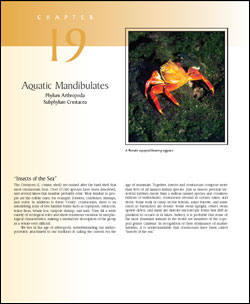
 | “Insects of the Sea”The Crustacea (L. crusta, shell) are named after the hard shell that most crustaceans bear. Over 67,000 species have been described, and several times that number probably exist. Most familiar to people are the edible ones, for example, lobsters, crayfishes, shrimps, and crabs. In addition to these “crusty” crustaceans, there is an astonishing array of less familiar forms such as copepods, ostracods, water fleas, whale lice, tadpole shrimp, and krill. They fill a wide variety of ecological roles and show enormous variation in morphological characteristics, making a satisfactory description of the group as a whole very difficult. We live in the age of arthropods, notwithstanding our anthropocentric attachment to our tradition of calling the current era the age of mammals. Together, insects and crustaceans compose more than 80% of all named animal species. Just as insects pervade terrestrial habitats (more than a million named species and countless trillions of individuals), crustaceans abound in oceans, lakes, and rivers. Some walk or creep on the bottom, some burrow, and some (such as barnacles) are sessile. Some swim upright, others swim upside down, and many are delicate microscopic forms that drift as plankton in oceans or in lakes. Indeed, it is probable that some of the most abundant animals in the world are members of the copepod genus Calanus. In recognition of their dominance of marine habitats, it is understandable that crustaceans have been called “insects of the sea.” |